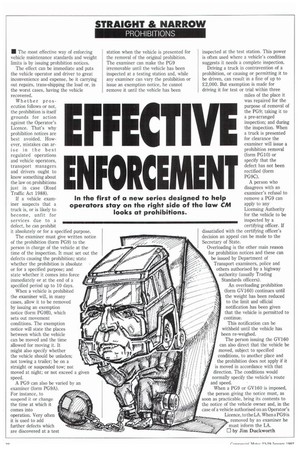FF CT
Page 30

If you've noticed an error in this article please click here to report it so we can fix it.
FORCE
In the first of a new series designed to help operators stay on the right side of the law CM looks at prohibitions.
• The most effective way of enforcing vehicle maintenance standards and weight limits is by issuing prohibition notices.
The effect can be immediate and puts the vehicle operator and driver to great inconvenience and expense, be it carrying out repairs, trans-shipping the load or, in the worst cases, having the vehicle recovered.
Whether prosecution follows or not, the prohibition is itself grounds for action against the Operator's Licence. That's why prohibition notices are best avoided. However, mistakes can arise in the best regulated operations and vehicle operators, transport managers and drivers ought to know something about the law on prohibitions just in case (Road Traffic Act 1988).
If a vehicle examiner suspects that a truck is, or is likely to become, unfit for services due to a defect, he can prohibit it absolutely or for a specified purpose.
The examiner must give written notice of the prohibition (form PG9) to the person in charge of the vehicle at the time of the inspection. It must set out the defects causing the prohibition; state whether the prohibition is absolute or for a specified purpose; and state whether it comes into force immediately or at the end of a specified period up to 10 days.
When a vehicle is prohibited the examiner will, in many cases, allow it to be removed by issuing an exemption notice (form PG9B), which sets out movement conditions. The exemption notice will state the places between which the vehicle can be moved and the time allowed for moving it. It might also specify whether the vehicle should be unladen; not towing a trailer; be on a straight or suspended tow; not moved at night; or not exceed a given speed.
A PG9 can also be varied by an examiner (form PG9A). For instance, to suspend it or change the time at which it comes into operation. Very often it is used to add further defects which are discovered at a test station when the vehicle is presented for the removal of the original prohibition. The examiner can make the PG9 irremovable until the vehicle has been inspected at a testing station and, while any examiner can vary the prohibition or issue an exemption notice, he cannot remove it until the vehicle has been inspected at the test station. This power is often used where a vehicle's condition suggests it needs a complete inspection.
Driving a truck in contravention of a prohibition, or causing or permitting it to be driven, can result in a fine of up to 2,000. But exemption is made for driving it for test or trial within three miles of the place it was repaired for the purpose of removal of the PG9; taking it to a pre-arranged inspection; and during the inspection. When a truck is presented for clearance the examiner will issue a prohibition removal (form PG10) or specify that the defect has not been rectified (form PG9C).
A person who disagrees with an examiner's refusal to remove a PG9 can apply to any Licensing Authority for the vehicle to be inspected by a certifying officer. If dissatisfied with the certifying officer's decision an appeal can be made to the Secretary of State.
Overloading is the other main reason for prohibition notices and these can be issued by Department of Transport examiners, police and others authorised by a highway authority (usually Trading Standards officers).
An overloading prohibition (form GV160) continues until the weight has been reduced to the limit and official notification has been given that the vehicle is permitted to continue.
This notification can be withheld until the vehicle has been re-weighed.
The person issuing the GV160 can also direct that the vehicle be moved, subject to specified conditions, to another place and the prohibition does not apply if it is moved in accordance with that direction. The conditions would normally specify the vehicle's route and speed.
When a PG9 or GV160 is imposed, the person giving the notice must, as soon as practicable, bring its contents to the notice of the vehicle owner and, in the case of a vehicle authorised on an Operator's Licence, to the LA. When a PG9 is removed by an examiner he must inform the LA.
0 by Jim Duckworth
































































































































































